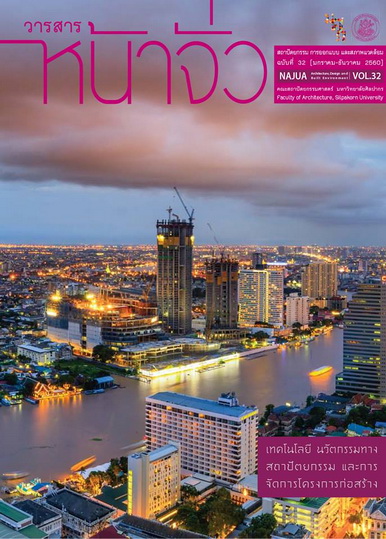สิ่งแฝงเร้นภายใต้รูปทรงเรือนไทยของเรือนพื้นถิ่นไทย-มอญ และไทย-ลาว ในพื้นที่ลุ่มนํ้าภาคกลางของประเทศไทย
Keywords:
เรือนไทย-ลาว, เรือนไทย-มอญ, Thai-Lao House, Thai-Mon HouseAbstract
ในพื้นที่ภาคกลางของประเทศไทย รูปทรงของเรือนไทยแบบประเพณีภาคกลางเสมือนจะแผ่เงาครอบคลุมการอยู่อาศัยของผู้คนหลากหลายกลุ่มชาติพันธุ์ อาทิเช่น มอญ ลาว จีน และอื่นๆ ซึ่งทำให้เกิดข้อกังขาว่า ภายใต้รูปลักษณ์ของเรือนไทยประเพณีนั้น วิถีในการอยู่อาศัยของกลุ่มชนต่างๆ นั้นเป็นอย่างไร มีสิ่งใดแฝงเร้นที่บ่งบอกลักษณะเฉพาะของแต่ละกลุ่มบ้างหรือไม่
บทความวิจัยนี้ตั้งคำถามดังกล่าวกับกลุ่มไทย-มอญ และไทย-ลาวในพื้นที่ลุ่มน้ำภาคกลางโดยอาศัยกระบวนการศึกษาจากการทบทวนวรรณกรรมเกี่ยวเนื่องต่างๆ ที่เน้นเรือนไทยของแต่ล่ะกลุ่มชนผนวกกับการศึกษาสภาพจริงจากภาคสนาม และการสำรวจสัมภาษณ์เพิ่มเติม
ผลของการศึกษาพบว่า สิ่งที่แฝงเร้นอยู่ในการอ่านลักษณะเฉพาะของเรือนไทย-มอญ และไทย-ลาวที่แสดงอัตลักษณ์ทางวัฒนธรรมเฉพาะได้อย่างชัดเจน คือ พื้นที่ศักดิ์สิทธิ์ในความเชื่อของทั้งมอญและลาวในการอยู่อาศัยภายใต้ร่มเงาของเรือนไทย ซึ่งปรากฏอยู่ในพิธีกรรมและสัญลักษณ์ทางความเชื่อต่างๆ อย่างเข้มข้น ทำให้เรือนไทย-มอญ และเรือนไทย-ลาว มีเอกลักษณ์เฉพาะตัวของการใช้เนื้อที่ภายในเรือนที่แตกต่างจากเรือนไทยโดยทั่วไป และยังส่งผลต่อรูปลักษณ์ของเรือนที่เน้นความสำคัญของพื้นที่ศักดิ์สิทธิ์ผ่านจั่วหลักของเรือน ซึ่งมีพื้นที่ต่อเนื่องกับโถงกลางเรือนซึ่งคลุมด้วยจั่วรอง หรือหลังคาปีกนกขนาดใหญ่ ซึ่งทำให้รูปลักษณ์ของเรือนไทยมอญ และไทยลาวเป็นเรือนจั่วแฝดผสมหลังคาปีกนก ซึ่งต่างไปจากเรือนล้อมชานกลางของเรือนไทยประเพณีภาคกลาง
The Hidden Dimension in the Traditional Thai Houses of the Thai-Mon and Thai-Lao Vernacular Houses in the Central Regions River Basin of Thailand
Ornsiri Panin
Faculty of Architecture, Silpakorn University
In the Central Region of Thailand, the form of the Thai Traditional houses seems to over-shadow almost of various ethnic groups such as the Mon, Lao and Chinese. Thus should be doubted that, under the shadow of Thai traditional houses, how is the way of living? Are there any hidden dimensions which lead to the identity of each group? This research article raised this question to the Thai-Mon and Thai Lao under the Thai Traditional houses in this area. The answer conducted by using the process of literature review in combination with the extra field survey, observation and in-depth interview with the clearly analysis cases study from literature review. It was found that, the hidden dimensions from the reading of architectural space, form and activities of the Thai-Mon and Thai Lao houses are the cultural identities of each group which can be clearly defined by the sacred space and activities under the main gable of the house in adjacent to the main hall, which strongly expressed by the sacred activities and sacred symbol involved. Thus, make the atmosphere of the Thai-Mon and Thai-Lao house differed from the Thai house. Furthermore, it effects to the house form which stress the most important sacred space under the main roof gable and spreading other activities under the secondary roof gable and the overhanging roof. These turn the characteristic of the house from the Central Thai traditional pattern of grouping of houses around the open court yard to be the double gables Thai houses with overhanging roof, which are Thai houses with Mon and Lao identities.





